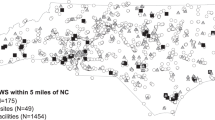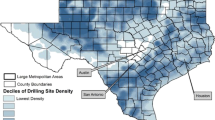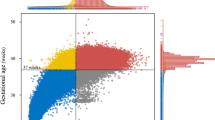Abstract
Background
Hydraulic fracturing, a method used in Northeastern British Columbia (Canada) to extract natural gas, can release contaminants with potential deleterious health effects on fetal development. To date, the association between hydraulic fracturing activity and birth outcomes has not been evaluated in this region.
Objective
To evaluate the association between the hydraulic fracturing well density/proximity and birth outcomes (birthweight, head circumference, preterm birth and small for gestational age (SGA)).
Methods
We used birth records from the Fort St John hospital between December 30, 2006 and December 29, 2016 (n = 6333 births). To estimate gestational exposure, we used inverse distance weighting (IDW) to calculate the density/proximity of hydraulic fracturing wells to pregnant women’s postal code centroid. For each birth, we calculated three IDWs using 2.5, 5, and 10 km buffer zones around women’s postal code centroid. We used linear and logistic regressions to evaluate associations between quartiles of postal code well density/proximity and birth outcomes, controlling for relevant covariates.
Results
No associations were found between postal code well density/proximity and head circumference or SGA. A negative association was found between postal code well density/proximity and birthweight for infants born to women in the 2nd quartile of the 10 km buffer (β [95% confidence interval (CI)]: −47.28 g [−84.30; −10.25]), and in the 2nd (β [95% CI]: −40.87 g [−78.01; −3.73]) and 3rd (β [95% CI]: −42.01 g [−79.15; −4.87]) quartiles of the 5 km buffer. Increased odds of preterm birth were observed among women in the 2nd quartile of the 2.5 km buffer (odds ratio (OR) [95% CI]: 1.60 [1.30; 2.43]).
Conclusions
This is the first epidemiological study in Northeastern British Columbia evaluating associations between hydraulic fracturing and health outcomes. Our results show inconsistent patterns of association between hydraulic fracturing, preterm birth and reduced birthweight, and effect estimates did not match expected dose-response relationships.
This is a preview of subscription content, access via your institution
Access options
Subscribe to this journal
Receive 6 print issues and online access
$259.00 per year
only $43.17 per issue
Buy this article
- Purchase on Springer Link
- Instant access to full article PDF
Prices may be subject to local taxes which are calculated during checkout
Similar content being viewed by others
References
Adams C, Janicki E, Balogun A. Summary of shale gas activity in Northeast British Columbia 2013. In: Oil and gas reports 2016. British Columbia Ministry of Natural Gas Development. 2016;1–39.
Johnson EG, Johnson LA. Hydraulic fracture water usage in northeast British Columbia: Locations, volumes and trends. Geoscience Reports 2012;2012:41–63.
Werner AK, Vink S, Watt K, Jagals P. Environmental health impacts of unconventional natural gas development: a review of the current strength of evidence. Sci Total Environ. 2015;505:1127–41.
Crowe E, Patton S, Thomas D, Thorpe B. When the wind blows: tracking toxic chemicals in gas fields and impacted communities. (Cobbing M. ed.) Battleboro, VT; 2016. https://comingcleaninc.org/assets/media/documents/When%20the%20Wind%20Blows.pdf.
Gilman JB, Lerner B, Kuster W, De Gouw J. Source signature of volatile organic compounds from oil and natural gas operations in northeastern Colorado. Environ Sci Technol. 2013;47:1297–305.
Macey GP, Breech R, Chernaik M, Cox C, Larson D, Thomas D, et al. Air concentrations of volatile compounds near oil and gas production: a community-based exploratory study. Environ Health. 2014;13:82.
Vengosh A, Jackson RB, Warner N, Darrah TH, Kondash A. A critical review of the risks to water resources from unconventional shale gas development and hydraulic fracturing in the United States. Environ Sci Technol. 2014;48:8334–48.
Fontenot BE, Hunt LR, Hildenbrand ZL, Carlton JrDD, Oka H, Walton JL, et al. An evaluation of water quality in private drinking water wells near natural gas extraction sites in the Barnett Shale Formation. Environ Sci Technol. 2013;47:10032–40.
Wisen J, Chesnaux R, Wendling G, Werring J, Barbecot F, Baudron P. Assessing the potential of cross-contamination from oil and gas hydraulic fracturing: A case study in northeastern British Columbia, Canada. J Environ Manag. 2019;246:275–82.
Wisen J, Chesnaux R, Werring J, Wendling G, Baudron P, Barbecot F. A portrait of wellbore leakage in northeastern British Columbia, Canada. Proc. Nat. Acad. Sci. 2020;117:913–22.
Caron-Beaudoin É, Valter N, Chevrier J, Ayotte P, Frohlich K, Verner M-A. Gestational exposure to volatile organic compounds (VOCs) in Northeastern British Columbia, Canada: a pilot study. Environ Int. 2018;110:131–8.
Caron-Beaudoin É, Bouchard M, Wendling G, Barroso A, Bouchard MF, Ayotte P, et al. Urinary and hair concentrations of trace metals in pregnant women from Northeastern British Columbia, Canada: a pilot study. J Exposure Sci Environ Epidemiol. 2019;29:613–23.
Goullé J-P, Mahieu L, Castermant J, Neveu N, Bonneau L, Lainé G, et al. Metal and metalloid multi-elementary ICP-MS validation in whole blood, plasma, urine and hair: reference values. Forensic Sci Int. 2005;153:39–44.
Bamber AM, Hasanali SH, Nair AS, Watkins SM, Vigil DI, Van Dyke M, et al. A systematic review of the epidemiologic literature assessing health outcomes in populations living near oil and natural gas operations: study quality and future recommendations. Int J Env Res Public Health. 2019;16:2123.
Casey JA, Savitz DA, Rasmussen SG, Ogburn EL, Pollak J, Mercer DG, et al. Unconventional natural gas development and birth outcomes in Pennsylvania, USA. Epidemiol (Camb, Mass). 2016;27:163–72.
Currie J, Greenstone M, Meckel K. Hydraulic fracturing and infant health: new evidence from Pennsylvania. Sci Adv. 2017;3:e1603021.
Hill EL. Shale gas development and infant health: evidence from Pennsylvania. J Health Econ. 2018;61:134–50.
McKenzie LM, Guo R, Witter RZ, Savitz DA, Newman LS, Adgate JL. Birth outcomes and maternal residential proximity to natural gas development in rural Colorado. Environ Health Perspect (Online). 2014;122:412.
Stacy SL, Brink LL, Larkin JC, Sadovsky Y, Goldstein BD, Pitt BR, et al. Perinatal outcomes and unconventional natural gas operations in Southwest Pennsylvania. PloS ONE. 2015;10:e0126425.
Whitworth KW, Marshall AK, Symanski E. Drilling and production activity related to unconventional gas development and severity of preterm birth. Environ Health Persp. 2018;126:037006.
Whitworth KW, Marshall AK, Symanski E. Maternal residential proximity to unconventional gas development and perinatal outcomes among a diverse urban population in Texas. PLOS ONE. 2017;12:e0180966.
Busby C, Mangano JJ. There’s a world going on underground—infant mortality and fracking in Pennsylvania. J Environ Prot. 2017;8:381–93.
Heinze G, Dunkler D. Five myths about variable selection. Transpl Int. 2017;30:6–10.
Kang M, Kanno CM, Reid MC, Zhang X, Mauzerall DL, Celia MA, et al. Direct measurements of methane emissions from abandoned oil and gas wells in Pennsylvania. Proc Natl Acad Sci. 2014;111:18173–7.
Kang M, Christian S, Celia MA, Mauzerall DL, Bill M, Miller AR, et al. Identification and characterization of high methane-emitting abandoned oil and gas wells. Proc Natl Acad Sci. 2016;113:13636–41.
Schout G, Griffioen J, Hassanizadeh SM, de Lichtbuer GC, Hartog N. Occurrence and fate of methane leakage from cut and buried abandoned gas wells in the Netherlands. Sci Total Environ. 2019;659:773–82.
Alawattegama SK, Kondratyuk T, Krynock R, Bricker M, Rutter JK, Bain DJ, et al. Well water contamination in a rural community in southwestern Pennsylvania near unconventional shale gas extraction. J Environ Sci Health, Part A. 2015;50:516–28.
Adgate JL, Goldstein BD, McKenzie LM. Potential public health hazards, exposures and health effects from unconventional natural gas development. Environ Sci Technol. 2014;48:8307–20.
Colborn T, Schultz K, Herrick L, Kwiatkowski C. An exploratory study of air quality near natural gas operations. Hum Ecol Risk Assess: Int J. 2014;20:86–105.
Pétron G, Frost G, Miller BR, Hirsch AI, Montzka SA, Karion A, et al. Hydrocarbon emissions characterization in the Colorado Front Range: a pilot study. J Geophys Res: Atmosph. 2012;117(D4).
Zielinska B, Fujita E, Campbell D. Monitoring of emissions from Barnett Shale natural gas production facilities for population exposure assessment. Desert Research Institute; 2011. p. 71.
Aguilera I, Guxens M, Garcia-Esteban R, Corbella T, Nieuwenhuijsen MJ, Foradada CM, et al. Association between GIS-based exposure to urban air pollution during pregnancy and birth weight in the INMA Sabadell Cohort. Environ Health Perspect. 2009;117:1322.
Chen D, Cho S-I, Chen C, Wang X, Damokosh AI, Ryan L, et al. Exposure to benzene, occupational stress, and reduced birth weight. Occup Environ Med. 2000;57:661–7.
Ha E, Cho S-I, Chen D, Chen C, Ryan L, Smith TJ, et al. Parental exposure to organic solvents and reduced birth weight. Arch Environ Health: Int J. 2002;57:207–14.
Slama R, Thiebaugeorges O, Goua V, Aussel L, Sacco P, Bohet A, et al. Maternal personal exposure to airborne benzene and intrauterine growth. Environ Health Perspect. 2009;117:1313–21.
Zahran S, Weiler S, Mielke HW, Pena AA. Maternal benzene exposure and low birth weight risk in the United States: A natural experiment in gasoline reformulation. Environ Res. 2012;112:139–46.
Zota AR, Ettinger AS, Bouchard M, Amarasiriwardena CJ, Schwartz J, Hu H, et al. Maternal blood manganese levels and infant birth weight. Epidemiol (Camb, Mass). 2009;20:367.
Shirai S, Suzuki Y, Yoshinaga J, Mizumoto Y. Maternal exposure to low-level heavy metals during pregnancy and birth size. J Environ Sci Health Part A. 2010;45:1468–74.
Ghosh JKC, Wilhelm M, Ritz B. Effects of residential indoor air quality and household ventilation on preterm birth and term low birth weight in Los Angeles County, California. Am J Public Health. 2013;103:686–94.
Llop S, Ballester F, Estarlich M, Esplugues A, Rebagliato M, Iñiguez C. Preterm birth and exposure to air pollutants during pregnancy. Environ Res. 2010;110:778–85.
Estarlich M, Ballester F, Davdand P, Llop S, Esplugues A, Fernández-Somoano A, et al. Exposure to ambient air pollution during pregnancy and preterm birth: a Spanish multicenter birth cohort study. Environ Res. 2016;147:50–8.
Poirier A, Dodds L, Dummer T, Rainham D, Maguire B, Johnson M. Maternal exposure to air pollution and adverse birth outcomes in Halifax, Nova Scotia. J Occup Environ Med. 2015;57:1291–8.
Wang H, Liu L, Hu Y-F, Hao J-H, Chen Y-H, Su P-Y, et al. Association of maternal serum cadmium level during pregnancy with risk of preterm birth in a Chinese population. Environ Pollut. 2016;216:851–7.
Yang J, Huo W, Zhang B, Zheng T, Li Y, Pan X, et al. Maternal urinary cadmium concentrations in relation to preterm birth in the Healthy Baby Cohort Study in China. Environ Int. 2016;94:300–6.
Ferguson KK, Chin HB. Environmental chemicals and preterm birth: biological mechanisms and the state of the science. Curr Epidemiol Rep. 2017;4:56–71.
Kassotis CD, Klemp KC, Vu DC, Lin C-H, Meng C-X, Besch-Williford CL, et al. Endocrine-disrupting activity of hydraulic fracturing chemicals and adverse health outcomes after prenatal exposure in male mice. Endocrinology. 2015;156:4458–73.
Webb E, Bushkin-Bedient S, Cheng A, Kassotis CD, Balise V, Nagel SC. Developmental and reproductive effects of chemicals associated with unconventional oil and natural gas operations. Rev Environ Health. 2014;29:307–18.
Vandenberg LN, Colborn T, Hayes TB, Heindel JJ, Jacobs DR Jr, Lee D-H, et al. Hormones and endocrine-disrupting chemicals: low-dose effects and nonmonotonic dose responses. Endocr Rev. 2012;33:378–455.
Nagata C, Iwasa S, Shiraki M, Shimizu H. Estrogen and α-fetoprotein levels in maternal and umbilical cord blood samples in relation to birth weight. Cancer Epidemiol Biomarkers Prev Biomarkers. 2006;15:1469–72.
Casey BM, Dashe JS, Wells CE, McIntire DD, Byrd W, Leveno KJ, et al. Subclinical hypothyroidism and pregnancy outcomes. Obstet Gynecol. 2005;105:239–45.
Abalovich M, Gutierrez S, Alcaraz G, Maccallini G, Garcia A, Levalle O. Overt and subclinical hypothyroidism complicating pregnancy. Thyroid. 2002;12:63–8.
Smylie J, Crengle S, Freemantle J, Taualii. Indigenous birth outcomes in Australia, Canada, New Zealand and the United States–an overview. Open Women’s Health J. 2010:7–17. https://doi.org/10.2174/1874291201004010007.
Luo Z-C, Wilkins R, Heaman M, Smylie J, Martens PJ, McHugh NG, et al. Birth outcomes and infant mortality among First Nations Inuit, and non-Indigenous women by northern versus southern residence, Quebec. J Epidemiol Community Health. 2012;66:328–33.
Luo Z-C, Senécal S, Simonet F, Guimond É, Penney C, Wilkins R. Birth outcomes in the Inuit-inhabited areas of Canada. CMAJ. 2010;182:235–42.
Wenman WM, Joffres MR, Tataryn IV. A prospective cohort study of pregnancy risk factors and birth outcomes in Aboriginal women. Cmaj. 2004;171:585–9.
Auger N, Luo Z, Platt R, Daniel M. Do mother’s education and foreign born status interact to influence birth outcomes? Clarifying the epidemiological paradox and the healthy migrant effect. J Epidemiol Community Health. 2008;62:402–9.
Acknowledgements
ECB is supported by a Canadian Institutes of Health Research postdoctoral fellowship (FRN 159262). MAV is the recipient of a Research Scholar J1 Award from the Fonds de recherche du Québec—Santé (FRQS). The authors would like to thank Northern Health for providing the birth records data, as well as the Treaty 8 Tribal Association for their support.
Author information
Authors and Affiliations
Corresponding author
Ethics declarations
Conflict of interest
The authors declare that they have no conflict of interest.
Additional information
Publisher’s note Springer Nature remains neutral with regard to jurisdictional claims in published maps and institutional affiliations.
Supplementary information
Rights and permissions
About this article
Cite this article
Caron-Beaudoin, É., Whitworth, K.W., Bosson-Rieutort, D. et al. Density and proximity to hydraulic fracturing wells and birth outcomes in Northeastern British Columbia, Canada. J Expo Sci Environ Epidemiol 31, 53–61 (2021). https://doi.org/10.1038/s41370-020-0245-z
Received:
Revised:
Accepted:
Published:
Issue Date:
DOI: https://doi.org/10.1038/s41370-020-0245-z
Keywords
This article is cited by
-
Assessing gestational exposure to trace elements in an area of unconventional oil and gas activity: comparison with reference populations and evaluation of variability
Journal of Exposure Science & Environmental Epidemiology (2023)
-
Congenital anomalies associated with oil and gas development and resource extraction: a population-based retrospective cohort study in Texas
Journal of Exposure Science & Environmental Epidemiology (2023)
-
Historic redlining and the siting of oil and gas wells in the United States
Journal of Exposure Science & Environmental Epidemiology (2023)
-
A new method for estimating ore grade based on sample length weighting
Scientific Reports (2023)
-
Assessing Exposure to Unconventional Oil and Gas Development: Strengths, Challenges, and Implications for Epidemiologic Research
Current Environmental Health Reports (2022)



